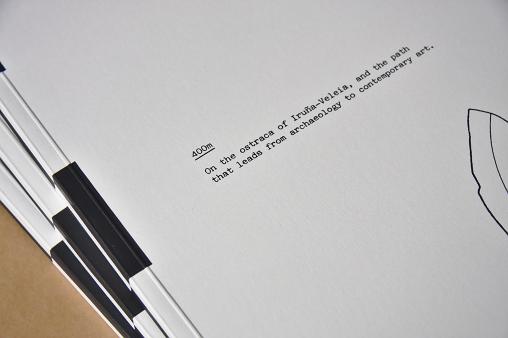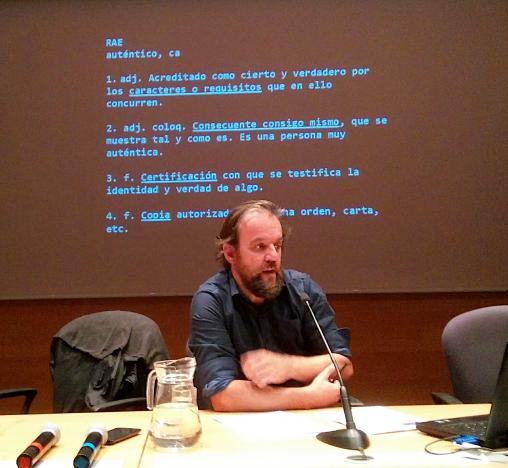dinsdag, 22 augustus, 2017 - 23:01

On the ostraca of Iruña-Veleia, and the path that leads from archaeology to contemporary art.
400m is the distance between the museum of archaeology and the museum of contemporary art in Vitoria-Gasteiz, in Basque Country. It is also the title of our new book on the controversy surrounding the archaeological discovery of the "ostraca" from Iruña-Veleia: Roman potsherds with engravings of images, texts in Latin and what appeared to be the earliest written manifestation of the Basque language, which were deemed a forgery by a select commission of academic experts.
The book will be presented for the first time at the exhibition "The Materiality of the Invisible" in the Van Eyck Academy, and will be for sale during the annual convention of the European Association of Archaeologists taking place in Maastricht from 30 August to 3 September.
With texts by Iñaki Martínez de Albéniz, Harkaitz Cano, Iratxe Jaio and Klaas van Gorkum.
Printed with a mimeograph at the Charles Nypels Lab in the Van Eyck Multiform institute for fine art, design and reflection.
Lees verder
dinsdag, 22 augustus, 2017 - 22:37
In september we will be participating in the Entre Nous Basiskamp, an investigative project related to the welfare state. A military style camp will be the setting for a number of activities, debates and presentations tackling subjects such as democracy, labour, education, poverty and (health) care. Several artists have been selected from each province, to live and work for one month in and from the camp.
Lees verder
maandag, 21 augustus, 2017 - 18:04
The Materiality of the Invisible opens on the 29th of August in Maastricht, at the Van Eyck, Marres and Bureau Europa. The exhibition approaches contemporary art as a form of archaeology. New and strange worlds are uncovered, exposing current and social political realities. The artists' discoveries, narratives, and installations propose speculative pasts and futures. The combined exhibitions offer insights into our existence and make visible what inhabits the imagination.
We will be showing new work, The Stick and the Stone, as well as Nire ama Roman hil da, of which the video is now subtitled into English. Accompanying this installation is a new publication, 400m, which has been printed at the Charles Nypels Lab at the Van Eyck.
Lees verder
maandag, 13 februari, 2017 - 16:19
ARCOmadrid with Gallery Joey Ramone
Opening Section
22 - 26 February 2017
With pleasure we would like to invite you to visit the booth of Gallery Joey Ramone at the artfair ARCO, where we will be showing our installation WORK IN PROGRESS.
Lees verder
donderdag, 13 oktober, 2016 - 23:16
Antes del encuentro "La solicitud de prestamo - Proklama 8" organizado en colaboración con Azala Espazio Kreazioa y Artium, Centro Museo de Arte Contemporáneo, se han publicado varios artículos en la prensa. (Correo, Berria y Noticias de Álava)
Lees verder
dinsdag, 11 oktober, 2016 - 09:50
Group Exhibition, 21 October 2016 - 5 February 2017
Tabakalera International Centre for Contemporary Culture, Donostia - San Sebastián
The Agency of Living Organisms exhibition seeks to address the interrelations between contemporary urban social structures and nature, from the artistic and collective perspective, by means of organising transient "living” structures, micro-political actions and interventions. Compared to humans, plants and other living organisms have a set of sensorial characteristics that are often surprisingly sophisticated with which they interact and exist in their environment, in the same way that happens in art.
Curated by Pauline Doutreluingne. With Lara Almarcegui, Iain Ball, El Conde de Torrefiel, New Mineral Collective, Tue Greenfort, Iratxe Jaio and Klaas van Gorkum, Anne Duk Hee Jordan, Esther Kokmeijer, Nader Koochaki, Maider López, Gerard Ortín, Tere Recarens, Koenraad Van den Driessche.
Lees verder
donderdag, 6 oktober, 2016 - 12:23
An installation with objects of porcelain, cast from molds that were recuperated from an abandoned factory near Donostia-San Sebastián. This project is the third case study in our artistic investigation of the factory as a paradigmatic site of the twentieth century. Just like in our previous projects, “Producing time in between other things” and “Work in progress”, we approach the factory with a research method that is analogous to experimental archaeology. That is to say, we aren’t merely interested in studying historical remains and forgotten artefacts for their own sake, but aim to activate them and reconstruct the ephemeral processes they were once a part of.
Lees verder
woensdag, 5 oktober, 2016 - 13:45

A public symposium coordinated by the artists Iratxe Jaio and Klaas van Gorkum, on the implications of exhibiting the original artefacts from a contested archaeological discovery in a Museum of Contemporary Art.
In 2016 the artists submitted a formal loan application to the Basque Government, in order to mount an exhibition of ancient Roman potshards with inscriptions at Artium, the museum of contemporary art in Vitoria-Gasteiz. These artefacts, discovered at the archaeological site Iruña-Veleia, were the subject of an ongoing controversy, as they were suspected to be the product of an elaborate forgery. Inscribed with what is alleged to be the earliest recorded writing in the Basque language, they have never been exhibited in public and are currently under custody of Bibat, the archaeological museum of Alava, pending legal verdict on the question whether fraud has been committed.
To exhibit the pieces in the museum of contemporary art would require a physical displacement of only 400 meters, yet produce a radical change in discursive context. The authorities denied the request, as anticipated, so the artists invited several guests to reflect on the case and on the absence of the artefacts in the museum. The symposium has been devised as an encounter between artistic, scientific and political sensibilities. Each contributor presented a perspective on the archaeological evidence that moves beyond the false-authentic binary, and invites us to reflect on the implication of the public in the institutional processes that determine the fate of their own material culture.
Lees verder
donderdag, 25 augustus, 2016 - 14:16
The "Libro de los Plagios" (Book of Plagiarism) is a booklet that has been printed for distribution during an exhibition of a series of large charcoal drawings, and which mimics the style and content of a book originally published by the Basque sculptor Jorge Oteiza in 1991, which has gone out of print.
Lees verder
donderdag, 25 augustus, 2016 - 11:27
A series of charcoal drawings, based on the images from the "Libro de los Plagios" (The Book of Plagiarism). This book was published in 1991 by the Basque sculptor Oteiza, as an indictment of what he perceived to be a flagrant plagiarism of his work.
Lees verder